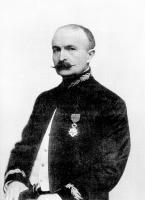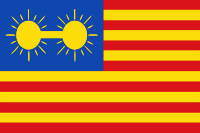Philippe Bunau-Varilla facts for kids
Quick facts for kids
Philippe-Jean Bunau-Varilla
|
|
|---|---|
 |
|
| Personal details | |
| Born | 26 July 1859 Paris, French Empire |
| Died | 18 May 1940 (aged 80) Paris, France |
| Nationality | French |
| Known for | Panama Canal |
Philippe-Jean Bunau-Varilla (born 26 July 1859 – died 18 May 1940) was a French engineer and soldier. He played a very important role in building the Panama Canal. With help from an American lawyer named William Nelson Cromwell, Bunau-Varilla helped convince the United States to build the canal in Panama. He also worked closely with President Theodore Roosevelt during the time Panama became independent from Colombia.
Contents
Early Life and Career
Philippe-Jean Bunau-Varilla was born in Paris, France, on July 26, 1859. He was a very smart student. At just 20 years old, he graduated from a famous engineering school called the École Polytechnique.
In 1882, he decided to leave his job in public works. He then traveled to Panama in 1884. There, he started working for Ferdinand de Lesseps's Panama Canal Company. He quickly became a top manager in the company.
The Panama Canal Project
After the first Panama Canal Company faced big financial problems in 1888, Bunau-Varilla was determined to see the canal built. He bought many shares in a new company, the New Panama Canal Company, back in France.
However, this new company also struggled to build the canal. They decided to sell their land in Panama to the United States. This way, they hoped to avoid losing everything.
Convincing the United States
When Theodore Roosevelt became president in 1901, the U.S. government became very interested in building the canal. Bunau-Varilla strongly pushed for the canal to be built in Panama. He worked with William Nelson Cromwell, a lawyer for the New Panama Canal Company.
Many people thought the canal should be built in Nicaragua instead. Nicaragua seemed less risky politically. But Bunau-Varilla worked hard to convince U.S. officials and the public. He even gave out Nicaraguan postage stamps that showed erupting volcanoes to senators! This was a clever way to suggest Nicaragua was unstable.
His efforts paid off. In 1902, the U.S. Congress agreed to pay $40 million to the New Panama Canal Company. This money was for the land in Panama. But first, the U.S. needed to make a deal with Colombia, which owned Panama at the time.
Panama's Independence
In 1903, Colombia signed a treaty to give land for the canal. But the Colombian Senate did not approve it. This put Bunau-Varilla's company at risk of losing the $40 million.
So, Bunau-Varilla started making plans with Panamanian groups in New York. These groups wanted Panama to become independent from Colombia. Bunau-Varilla even designed a new flag for Panama. He also helped plan the new nation's government. However, the Panamanian leaders later chose a different flag because Bunau-Varilla was a foreigner.
President Roosevelt supported the Panamanian separatists. He sent U.S. Navy ships to prevent Colombian forces from stopping the revolution. The fight for independence was quick and not very violent.
The Hay–Bunau-Varilla Treaty
After Panama became independent, Bunau-Varilla became Panama's ambassador to the United States. He was given special power to make agreements. Without getting official permission from the new Panamanian government, he quickly made a treaty with the U.S. Secretary of State, John Hay.
This treaty, called the Hay–Bunau-Varilla Treaty, gave the United States control over the Panama Canal area. No Panamanians signed this treaty. It was approved in Panama in December 1903. Many Panamanians felt that Bunau-Varilla, who hadn't lived in Panama for 17 years, had too much power. This treaty was eventually replaced in 1977 by the Torrijos–Carter Treaties.
Later Life in Paris
After his work on the Panama Canal, Bunau-Varilla went back to Paris. He continued to work as an engineer and wrote about money matters. He also became an expert in cleaning water with chlorine.
During World War I, he served as an officer in the French army. He was injured in the Battle of Verdun and lost a leg. Even as he got older, he kept pushing for changes to the canal. He wanted it to be a sea-level waterway, not one with locks.
In 1938, France honored him with a very high award, the Grand Cross of the Legion of Honor. Philippe-Jean Bunau-Varilla died in Paris on May 18, 1940.
Personal Wealth
Bunau-Varilla lived a very comfortable life. He had a beautiful home in Paris and enjoyed entertaining friends. He made his money not just as an engineer, but also from his own company. He ran this company, Artigue & Sonderegger, with his brother Maurice Bunau-Varilla. Maurice later became a wealthy owner of a major newspaper in Paris called Le Matin.
See also
 In Spanish: Philippe-Jean Bunau-Varilla para niños
In Spanish: Philippe-Jean Bunau-Varilla para niños
- Panama Canal
- William Nelson Cromwell


